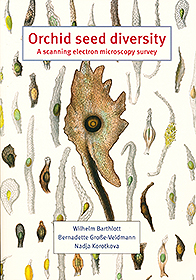Orchid seed diverstity,
A scanning electron microscopy survey.
by Bernadette Große-Veldman & Nadja Korotova.
2014, Botanic Garden and Botanic Museum Berlin-Dahlem (ed.) as Eglera 32.
ISSN 0170-4818
ISBN 978-3-92180-92-8
245 pp., several black-white photographs.

In this book we see that orchid seeds show a surprising diversity: sizes, shapes, the complexity and (light)weight of the seed coats’ architecture, …
About 1400 collections of orchid seeds have been analysed by SEM (scanning electron microscopy) and other methods over the last 40 years. About 7000 micrographs of 1100 species in 352 genera have been evaluated for this monograph on orchid seeds. Interesting and amazing!
The introduction (p. 12-18) is about known subjects (Current knowledge of orchid physiology, Seeds of Orchids) but also about not so commonly known items (Earlier seed morphology studies in Orchidaceae with some interesting illustrations f.i. the unique seeds of Chiloschista lunifera.
The chapter ‘Descriptors and terminology’ (p. 19-26) presents two subchapters: ‘Seed characters’ (seed shape, seed size, seed colour, nu!mber of testa cells, etc…) and ‘Seed types’.
The chapter ‘Material and methods’ gives insight in how and with what the authors worked for their studies that lead to this monograph.
A following chapter ‘Seed description’ (p. 29-86) describes the seeds of the Apostasioideae, Vanilloideae, Cypripedioideae, Orchidoideae, Epidendroideae: Seed shape, size, colour, shape of testa cells, anticlinal walls, cell corners, periclinal walls. References such as f.i. Arditti & Ghani (2000) and/or f.i. Fig. 81 G.H. are given when available.
A chapter ‘Discussion’ (p. 87- 94): The systemic and diagnostic value and evolution of orchid seed characters; Are orchid seeds systematically relevant (Earlier evidence from comparative studies & Earlier evidence from cladistics studies), etc..
From p. 95 to 185: SEM micrographs. Here we see clearly illustrated the amazing differences between orchid seeds from many orchid species.
This is followed by a chapter on ‘Selected seed characters visualised on phylogenetic trees’ (p. 186-212).
This monograph closes with ‘References’ (p. 213-216), an ‘Appendix with sources of material’ (p. 217-238) and an ‘Index’ (p. 239-245).
A lot of orchid aficionados just know that orchids have very tiny seeds, nothing more. They mainly have interest in growing orchids; a minority is really studying profoundly: mostly on just one genus. This book proves that not only orchid plants/flowers are different and worth studying, also their seeds are.